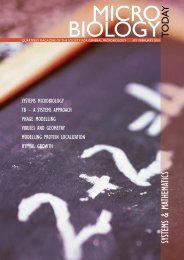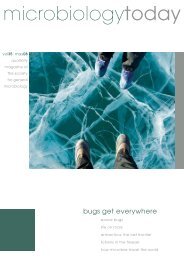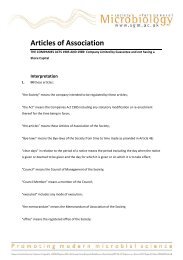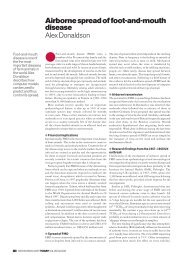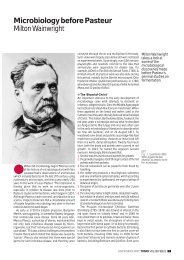Download - Society for General Microbiology
Download - Society for General Microbiology
Download - Society for General Microbiology
You also want an ePaper? Increase the reach of your titles
YUMPU automatically turns print PDFs into web optimized ePapers that Google loves.
end of a short stalk, which make up the closed loop, swell<br />
rapidly inwards, within 0.1 seconds crushing the worm like<br />
a noose around the neck. Death follows very quickly.<br />
Once ensnared, the fungus pierces the nematode’s cuticle<br />
using a narrow penetration peg, which swells inside the<br />
host to <strong>for</strong>m an infection bulb that the hyphae grow from.<br />
Fungal enzymes break down the contents of the nematode<br />
and the nutrients are translocated elsewhere within the<br />
hyphal system <strong>for</strong> growth or spore production. Growth does<br />
not occur at the site of the hyphal trap.<br />
This phase usually takes 1–3 days, be<strong>for</strong>e hyphae grow out<br />
of the cadaver and sporulate.<br />
Nutrition<br />
Predatory fungi have evolved these trapping devices to<br />
obtain nutrients and give them an edge over other types of<br />
organisms in habitats where population densities are high<br />
and consequently competition <strong>for</strong> resources is fierce.<br />
The primary function of predatory fungi is wood decay.<br />
Wood is mainly composed of carbohydrates: cellulose and<br />
lignocellulose. The carbon to nitrogen ratio (C:N) of wood<br />
is very high at 300:1–1,000:1 or even higher. For good<br />
growth to occur, most organisms require a C:N ratio of<br />
30:1 to produce nucleic acids, proteins and enzymes. For<br />
predatory fungi nitrogen is the limiting factor <strong>for</strong> growth.<br />
Nematophagus predatory fungi get their extra nitrogen from<br />
digesting the nematode’s biomass.<br />
This means that predatory fungi are not true saprotrophs<br />
(which live on dead organic matter) as two phases that run<br />
in parallel are necessary to supply them with the correct<br />
nutrients <strong>for</strong> growth – the predatory parasitic phase and the<br />
saprotrophic phase. Predatory fungi are facultative parasites.<br />
Biological control<br />
Experiments are being carried out to see if predatory<br />
fungi can be used to control parasitic nematodes that<br />
infect grazing animals such as sheep. These gastrointestinal<br />
The oyster mushroom<br />
Pleurotus ostreatus, the oyster mushroom, produces<br />
a very powerful toxin from special structures on<br />
its hyphae. This toxin paralyses the nematode, but<br />
doesn’t kill it. The fungus then sends out specialized<br />
directional hyphae that penetrate the nematode’s<br />
cuticle and digest the contents.<br />
nematodes can kill their host animal, leading to significant<br />
financial loss <strong>for</strong> the farmer. Treatment is almost<br />
exclusively with drugs that kill or expel the worms.<br />
However, nematodes are now becoming resistant to<br />
the drugs, so scientists are looking at other methods of<br />
treatment.<br />
One idea that is being tested is the use of the nematode<br />
trapping fungus Duddingtonia flagrans. This fungus uses<br />
the adhesive net technique to trap and kill nematodes.<br />
Researchers are feeding D. flagrans to the animal as spores,<br />
either directly in their food or in mineral licks. The fungal<br />
spores pass through the digestive system of the animal both<br />
unharmed and without germinating and are deposited<br />
on the grass in the faeces. The spores then germinate<br />
producing mycelia with hyphal traps that catch and kill<br />
the nematodes. This significantly reduces the number of<br />
nematodes on the pastureland that are able to reinfect the<br />
grazing animal.<br />
Dariel Burdass, SGM<br />
Further sources of in<strong>for</strong>mation<br />
www.pnas.org/content/104/20/8379.full<br />
www.uoguelph.ca/~gbarron/MISC2003/feb03.html<br />
Deacon J.W. (1997). Modern Mycology, 3rd edn. Ox<strong>for</strong>d:<br />
Blackwell Science.<br />
Jansson, H.-B. & others (1985). Differential adhesion and<br />
infection of nematodes by the endoparasitic fungus Meria<br />
coniospora. Appl Environ Microbiol 49, 552–555.<br />
MiSAC Poster Competition 2009 –<br />
Microbes and Climate Change<br />
This year SGM is sponsoring the annual competition, which asks school<br />
students in two age groups (KS 3 and GCSE) to produce an eye-catching poster<br />
to illustrate to their peer group one important aspect of the role of microbes in<br />
climate change. There are cash prizes <strong>for</strong> both the winning schools and students<br />
in each category. The closing date <strong>for</strong> entries is 31 March 2009.<br />
Checkout www.microbiologyonline.co.uk <strong>for</strong> details and to download an entry<br />
<strong>for</strong>m or email education@sgm.ac.uk <strong>for</strong> a competition flier and in<strong>for</strong>mative<br />
factfile about this subject.<br />
Book review<br />
Germ Stories<br />
A. Kornberg<br />
University Science Books<br />
(2007)<br />
£17.99 pp. 72<br />
ISBN 978-1-891389-51-1<br />
Hurry, hurry to the parade<br />
Of the strangest creatures<br />
ever made.<br />
No legs, no fins, no mouths,<br />
no eyes,<br />
Little beasties of the tiniest<br />
size<br />
Germ Stories is a charming anthology of microbiological<br />
verse. Written by the Nobel laureate Arthur Kornberg,<br />
it comprises 12 poems about bugs, both good and<br />
bad, beautiful and ugly. Originally intended as bedtime<br />
stories <strong>for</strong> his children, they have been updated <strong>for</strong> his<br />
grandchildren (and the 21st century) to include microbes<br />
such as HIV and Helicobacter pylori.<br />
This book is both educational and highly entertaining.<br />
The rhyming couplets are interspersed with Roberto<br />
Kolter’s fascinating photographs and accompanying<br />
explanatory text. The lyrical quality of Kornberg’s writing<br />
is complemented by Adam Alanz’s enchanting illustrations<br />
which strike a careful balance between the whimsical and<br />
the scientifically accurate.<br />
My only criticism would be that, considering its intended<br />
audience, some of the terminology is advanced. I doubt<br />
words like ‘microbiocide’, ‘ATP’ and ‘antitoxin’ normally<br />
feature in the average child’s bedtime tales (unless your<br />
Dad happened to win a Nobel prize in Medicine!), but the<br />
fluidity of his language fully compensates <strong>for</strong> this. It would<br />
certainly suit the inner child lurking in an adult biologist<br />
and what better way to teach your children the important,<br />
yet difficult, concepts of food hygiene, antibiotic resistance<br />
and vaccination?<br />
This is one of those tactile books that will survive the<br />
digital age. A hardback with huge, colourful images and<br />
thick, glossy pages, it invites you to snuggle up with it<br />
under a warm duvet or next to an open fire. It is a book<br />
to be treasured and would make an ideal Christmas<br />
present, <strong>for</strong> the young or old.<br />
Gemma Sims, SGM<br />
SGM at ASE Annual<br />
Conference 2009<br />
8–10 January, University of Reading<br />
SGM and the <strong>Microbiology</strong> in Schools Advisory<br />
Committee are joining <strong>for</strong>ces to promote microbiology at<br />
the Association <strong>for</strong> Science Education’s flagship event.<br />
Not only can teachers visit us on Stand CS31 in the<br />
Exhibition, to see our latest multimedia resource <strong>for</strong> KS3<br />
and GCSE Microbes: the Good, Bad and Ugly, but they can<br />
also hone their practical skills at our drop-in workshop.<br />
This will take place in a lab in the AMS Building, shared<br />
with prestigious safety body CLEAPSS.<br />
Under the banner Hands-on Practical <strong>Microbiology</strong> <strong>for</strong><br />
the new GCSEs, experts from MiSAC will demonstrate<br />
some essential methods which delegates can try out<br />
under their professional guidance. In addition there will<br />
be workstations with some simple but effective practical<br />
investigations to see.<br />
Biology in the Real World:<br />
Bringing the Curriculum to Life<br />
9 January 2009<br />
Room 109, Palmer Building, University of Reading<br />
SGM and MiSAC are also sponsoring a speaker on TB<br />
vaccines in this one-day symposium, which is organized by<br />
members of NUCLEUS.<br />
Dr Helen Fletcher, a senior postdoctoral scientist at the<br />
Nuffield Department of Clinical Medicine, Ox<strong>for</strong>d, will<br />
answer the question Why do we need a new vaccine <strong>for</strong><br />
tuberculosis? With 2 million deaths a year from TB and<br />
an estimated third of the world’s population infected<br />
with Mycobacterium tuberculosis, new vaccines <strong>for</strong> TB are<br />
urgently needed. Drug treatment and the BCG vaccine have<br />
failed to control the current epidemic. Dr Fletcher will<br />
talk about MVA85A, a new vaccine designed to boost the<br />
protective immune response induced by BCG, and discuss<br />
the scientific, clinical and ethical issues surrounding the<br />
development of new TB vaccines.<br />
The topic will be of particular interest to teachers of KS4<br />
and post-16 biology as factual and ethical issues relating to<br />
TB and vaccination figure large in the specifications.<br />
See www.ase.org.uk <strong>for</strong> further details of all events at the<br />
Annual Conference.<br />
Please note that anyone wishing to attend any event at the<br />
conference must register, either be<strong>for</strong>ehand or on-site.<br />
204 microbiology today nov 08 microbiology today nov 08 205



